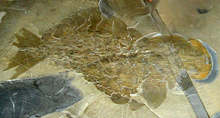Anomalocaris
Anomalocaris ("abnormal shrimp") is an extinct genus of anomalocaridid, which are, in turn, thought to be closely related to the arthropods. The first fossils of Anomalocaris were discovered in the Ogygopsis shale by Joseph Frederick Whiteaves, with more examples found by Charles Doolittle Walcott in the famed Burgess Shale.
| Anomalocaris Temporal range: Early to Late Cambrian
| |
|---|---|

| |
| Image of the first complete Anomalocaris fossil found, residing in the Royal Ontario Museum | |
| Scientific classification | |
| Kingdom: | |
| (unranked): | |
| Phylum: | |
| Class: | |
| Order: | |
| Family: | |
| Genus: | † Anomalocaris Whiteaves 1892
|
| Species | |
| |
Body Parts change
Anomalocaris lived in the Cambrian period, which was a long time before dinosaurs. This makes Anomalocaris very old, so their body parts haven't evolved to be as detailed as modern animals. However, Anomalocaris still had compound eyes which were very big and complex compared to other animals in the earlier parts of the Cambrian, and also had segmented (has many sections) front appendages which were used to grasp its prey like arms. So while Anomalocaris was around the size of a small lobster, it still was a very good apex predator for its time.
Behaviour change
Anomalocaris lived in the sea, like most of the plants (which were really small algae in the Cambrian) and animals during this time period. Recently, people now think that Anomalocaris didn't hunt trilobites and other benthic animals that lived on the sea floor, but instead swam after nekton like basal chordates (animals that can control how they move underwater, unlike plankton).
Being Called A Different Animal change
Anomalocaris was misidentified many times, as the mouth, front appendages and trunk (the rest of its body) were discovered separately multiple times, leading scientists to think for a while that these parts of Anomalocaris were, in fact, of three different animals, with the mouth thought to be a jellyfish, the front appendages thought to be a shrimp and the trunk thought to be a sea cucumber or sponge.